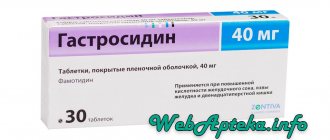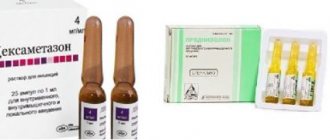Write a review
Reviews: 0
Manufacturers: Grodzisk Pharmaceutical Works Polfa Co. (Poland)
Active ingredients
- Meloxicam
Disease class
- Rheumatoid arthritis, unspecified
- Arthrosis, unspecified
- Ankylosing spondylitis
Clinical and pharmacological group
- Not indicated. See instructions
Pharmacological action
- Anti-inflammatory
- Antipyretic
- Analgesic (non-narcotic)
- Analgesic (narcotic)
Pharmacological group
- NSAIDs - Oxycams
Contraindications
Absolute:
- Severe liver failure;
- Peptic ulcer of the stomach and duodenum in the acute phase;
- Severe renal failure (if hemodialysis is not performed);
- Aspirin asthma;
- Pregnancy;
- Lactation;
- Age up to 15 years;
- Hypersensitivity to the drug.
Relative (requires special care and constant monitoring):
- Elderly age;
- History of erosive and ulcerative lesions of the gastrointestinal tract;
- Chronic heart failure with symptoms of circulatory failure;
- Cirrhosis of the liver;
- Hypovolemia as a result of surgery.
Mirlox
Non-steroidal anti-inflammatory drug (NSAID). It has anti-inflammatory, analgesic and antipyretic effects.
The anti-inflammatory effect is associated with inhibition of the enzymatic activity of COX-2, which is involved in the biosynthesis of prostaglandins in the area of inflammation. To a lesser extent, it affects COX-1, which is involved in the synthesis of prostaglandin, which protects the mucous membrane of the digestive tract and takes part in the regulation of blood flow in the kidneys.
Pharmacokinetics
Suction
After oral administration, it is well absorbed from the gastrointestinal tract. The absolute bioavailability of meloxicam is 89%. Concomitant food intake does not alter absorption.
When taking the drug orally in doses of 7.5 mg and 15 mg, the concentration of meloxicam in the blood plasma is proportional to the dose.
The range of differences between Cmax and Cmin in blood plasma after a single dose is relatively small and at a dose of 7.5 mg is 0.4-1 μg/ml, and at a dose of 15 mg – 0.8-2 μg/ml (both Cmin and Cmax values are given respectively).
Distribution
Css is achieved within 3-5 days. With long-term use of the drug (more than 1 year), concentrations are similar to those observed after the first achievement of an equilibrium state.
Plasma protein binding is more than 99%. Vd is small and averages 11 liters.
Meloxicam penetrates histohematic barriers, the concentration in synovial fluid reaches 50% of the Cmax of the drug in blood plasma.
Metabolism
Meloxicam is almost completely metabolized in the liver to form 4 pharmacologically inactive metabolites. The main metabolite, 5′-carboxymeloxicam (60% of the dose taken), is formed by oxidation of an intermediate metabolite, 5′-hydroxymethylmeloxicam, which is also excreted, but to a lesser extent (9% of the dose taken). In vitro studies have shown that the CYP2C9 isoenzyme plays an important role in this metabolic transformation; the CYP3A4 isoenzyme is of additional importance. Peroxidase, the activity of which probably varies individually, takes part in the formation of the other two metabolites (constituting 16% and 4% of the drug dose, respectively).
Removal
T1/2 of meloxicam is 15-20 hours. It is excreted equally in feces and urine, mainly in the form of metabolites. Less than 5% of the daily dose is excreted unchanged in feces; the drug is found unchanged in urine only in trace amounts. Plasma clearance averages 8 ml/min.
Pharmacokinetics in special clinical situations
In elderly people, drug clearance is reduced.
Moderate hepatic or renal impairment does not significantly affect the pharmacokinetics of meloxicam.
Side effects
- Digestive system: constipation, diarrhea, flatulence, abdominal pain, erosive and ulcerative lesions of the gastrointestinal tract, dry mouth, nausea, vomiting, increased activity of liver enzymes, gastrointestinal bleeding (latent or obvious), perforation of the stomach or intestines, esophagitis, stomatitis, colitis, hepatitis;
- Cardiovascular system: feeling of hot flashes, increased blood pressure, tachycardia;
- Respiratory system: cough, exacerbation of bronchial asthma;
- Central nervous system: tinnitus, confusion, disorientation, dizziness, sleep disturbance, headache;
- Urinary system: urinary tract infection, edema, proteinuria, hematuria, renal medullary necrosis, interstitial nephritis, renal failure;
- Hematopoietic system: leukopenia, anemia, thrombocytopenia;
- Organ of vision: blurred vision, conjunctivitis;
- Dermatological and allergic reactions: increased photosensitivity, skin rash, itching, urticaria, swelling of the lips and tongue, toxic epidermal necrolysis, anaphylactoid reactions (including anaphylactic shock), erythema multiforme, allergic vasculitis;
- Other: fever.
Directions for use and dosage
The tablets are taken orally with meals, the frequency of use is once a day.
Recommended doses (per day):
- Rheumatoid arthritis – 15 mg (depending on the therapeutic effect, the dose can be reduced to 7.5 mg);
- Osteoarthritis – 7.5 mg (if ineffective, the dose can be increased to 15 mg);
- Ankylosing spondylitis – 15 mg.
The maximum daily dose is no more than 15 mg.
In case of severe renal failure (in patients on hemodialysis) and an increased risk of side effects, the daily dose should not exceed 7.5 mg.
Drug interactions
Possible interaction reactions in case of simultaneous use of Mirlox with other drugs:
- Other NSAIDs, including acetylsalicylic acid: the risk of developing erosive and ulcerative lesions and bleeding from the gastrointestinal tract;
- Antihypertensive drugs: decreased effectiveness;
- Methotrexate: increased side effects on the hematopoietic system (risk of developing leukopenia and anemia);
- Lithium preparations: increase in their toxic effect;
- Diuretics and cyclosporine: risk of renal failure;
- Intrauterine contraceptives: decreased effectiveness;
- Anticoagulants (ticlopidine, heparin, warfarin) and thrombolytic drugs (fibrinolysin, (streptokinase): risk of bleeding;
- Cholestyramine: increased excretion through the gastrointestinal tract.
Similar drugs:
- Katadolon Capsule
- Ibuprom Max Oral tablets
- Solpadeine Effervescent tablets
- Milgamma compositum Dragee
- Mesipol Solution for intramuscular administration
- Xefocam (Xefocam) Lyophilisate for the preparation of solution for injection
- Melbek Solution for injection
- Efferalgan Rectal suppositories
- Mesulide Oral tablets
- Amidopyrinum Oral tablets
** The Drug Directory is intended for informational purposes only. For more complete information, please refer to the manufacturer's instructions. Do not self-medicate; Before starting to use Mirlox, you should consult a doctor. EUROLAB is not responsible for the consequences caused by the use of information posted on the portal. Any information on the site does not replace medical advice and cannot serve as a guarantee of the positive effect of the drug.
Are you interested in the drug Mirlox? Do you want to know more detailed information or do you need a doctor's examination? Or do you need an inspection? You can make an appointment with a doctor - the Euro lab is always at your service! The best doctors will examine you, advise you, provide the necessary assistance and make a diagnosis. You can also call a doctor at home . Euro lab clinic is open for you around the clock.
** Attention! The information presented in this medication guide is intended for medical professionals and should not be used as a basis for self-medication. The description of the drug Mirlox is provided for informational purposes and is not intended for prescribing treatment without the participation of a doctor. Patients need to consult a specialist!
If you are interested in any other drugs and medications, their descriptions and instructions for use, information about the composition and form of release, indications for use and side effects, methods of use, prices and reviews of drugs, or you have any other questions and suggestions - write to us, we will definitely try to help you.
Buy Mirlox tablets 15 mg No. 20 in pharmacies
Instructions for use Mirlox Dosage forms tablets 15 mg Synonyms Amelotex Arthrozan Bi-xicam Melbek Melbek forte Melox Meloxicam Meloflex Rompharm Mesipol Movalis Movasin Oxycamox Group Anti-inflammatory drugs - oxicams International nonproprietary name Meloxicam Composition Active ingredient - meloxicam. Manufacturers Grodziski Pharmaceutical Ltd. (Poland) Pharmacological action Has anti-inflammatory, analgesic, antipyretic effects. Well absorbed. Passes through histohematic barriers and penetrates into the synovial fluid. Subjects to biotransformation with the formation of inactive metabolites. Excreted in feces and urine in equal proportions. Side effects From the gastrointestinal tract: dyspepsia, nausea, vomiting, abdominal pain, esophagitis, gastroduodenal ulcers, constipation or diarrhea, flatulence. From the nervous system and sensory organs: dizziness, headache, ringing in the ears, drowsiness. Other: edema, increased blood pressure, palpitations, increased creatinine and/or serum urea, anemia, leukopenia, thrombocytopenia, photosensitivity, allergic reactions (rash, itching, bronchospasm, urticaria). Indications for use Rheumatoid arthritis, osteoarthritis, arthrosis and other inflammatory and degenerative diseases of the joints, accompanied by pain. Contraindications Hypersensitivity (including to NSAIDs of other groups), gastric ulcer in the acute stage, severe liver or end-stage renal failure, pregnancy, breastfeeding, adolescence (up to 15 years). Method of administration and dosage The drug is taken orally with meals. Recommended dosage regimen. Rheumatoid arthritis: 15 mg per day. Depending on the therapeutic effect, the dose can be reduced to 7.5 mg per day. Osteoarthritis: 7.5 mg per day. If ineffective, the dose can be increased to 15 mg per day. Ankylosing spondylitis: 15 mg per day. The maximum daily dose should not exceed 15 mg. In patients with severe renal failure undergoing hemodialysis, the dose should not exceed 7.5 mg per day. Overdose Symptoms: increased side effects. Treatment: gastric lavage and symptomatic therapy, administration of cholestyramine to accelerate elimination. Interaction Increases the risk of bleeding against the background of indirect anticoagulants, ticlopidine, heparin, thrombolytics. Increases the concentration of lithium in the blood plasma. Increases the toxicity of methotrexate (cytopenia), cyclosporine (nephrotoxicity). Reduces the effectiveness of antihypertensive drugs. Special instructions Use with caution for diseases of the upper gastrointestinal tract in the anamnesis, in combination with anticoagulants, myelotoxic drugs, incl. methotrexate. Prescribing NSAIDs to patients with reduced renal blood flow and volume may accelerate renal decompensation. The risk of developing such reactions is especially high in patients with symptoms of dehydration, congestive heart failure, liver cirrhosis, nephrotic syndrome and severe kidney disease, in patients receiving diuretics, as well as in those who have undergone significant surgery leading to hypovolemia (careful monitoring is required from the start of treatment diuresis and kidney function). If there is a significant deviation from the norm in the level of serum transaminases and other indicators characterizing liver function, you should stop taking it and conduct control laboratory tests. Prescribe with caution to elderly, weakened and exhausted patients. Storage conditions List B. In a dry place, protected from light, at room temperature.
special instructions
It is recommended to take Mirlox simultaneously with anticoagulant therapy under supervision due to the increased risk of erosive and ulcerative lesions of the gastrointestinal tract.
The drug is used with caution in patients with liver cirrhosis, chronic heart failure (with circulatory failure), as well as in people with hypovolemia due to surgical interventions.
If you are taking diuretics at the same time, you must drink enough fluid.
If photosensitivity and allergic reactions occur, you should contact your doctor, who will decide on the possibility of further taking the drug.
If side effects from the central nervous system develop (drowsiness, headache, dizziness), it is necessary to stop driving vehicles and servicing mechanisms and machines.





